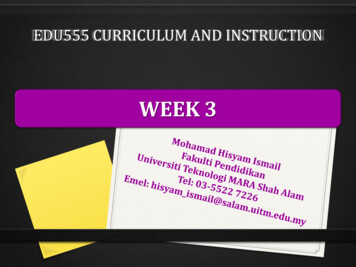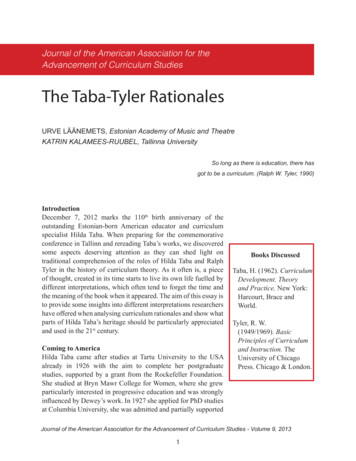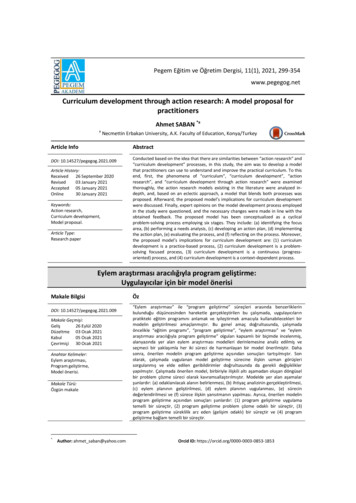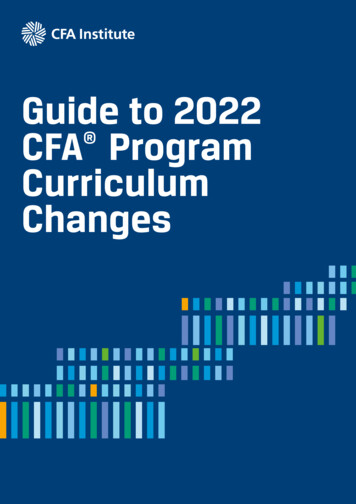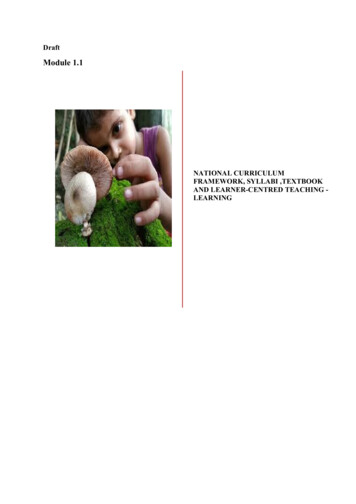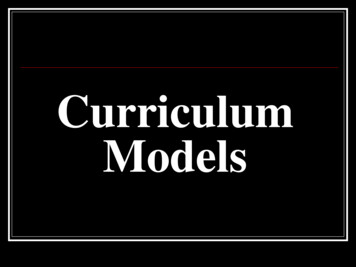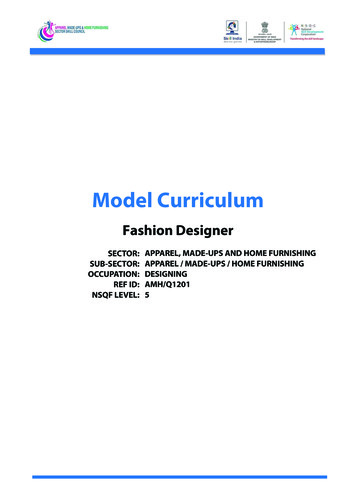
Transcription
Model CurriculumFashion DesignerSECTOR:SUB-SECTOR:OCCUPATION:REF ID:NSQF LEVEL:APPAREL, MADE-UPS AND HOME FURNISHINGAPPAREL / MADE-UPS / HOME FURNISHINGDESIGNINGAMH/Q12015
CertificateCURRICULUM COMPLIANCE TOQUALIFICATION PACK – NATIONAL OCCUPATIONALSTANDARDSis hereby issued by theAPPAREL MADE-UPS HOME FURNISHING SECTOR SKILL COUNCILfor theMODEL CURRICULUMComplying to National Occupational Standards ofJob Role/ Qualification Pack: ‘Fashion Designer’ QP No. ‘AMH/Q1201 NSQF Level 5’Date of Issuance:December 15, 2015Valid up to:December 15d, 2016* Valid up to the next review date of the Qualification PackDr. Roopak VasishthaChief Executive Officer(Apparel Made-ups Home FurnishingSector Skill Council)
TABLE OF CONTENTS1. Curriculum012. Trainer Prerequisites083. Annexure: Assessment Criteria09
Fashion DesignerCURRICULUM / SYLLABUSThis program is aimed at training candidates for the job of a “Fashion Designer”, in the “Apparel , Made Ups and HomeFurnishing” Sector/Industry and aims at building the following key competencies amongst the learnerProgram NameFashion DesigningQualification Pack Name &Reference ID. IDFashion Designer ; AMH/Q1201Version No.1.0Pre-requisites to TrainingTraining OutcomesVersion Update Date14–12 – 201612th pass, preferably1. Prepare to make a design collection2. Prepare prototype garments for the collection3. Evaluate the design development process4. Maintain the work area, tools, machines and computers5. Maintain health, safety and security at workplaceFashion Designer1
This course encompasses 5 out of 5 National Occupational Standards (NOS) of “Fashion Designer” Qualification Packissued by “APPAREL, MADE-UPS AND HOME FURNISHING SECTOR SKILL COUNCIL”.Sr. No.ModuleKey Learning OutcomesEquipment Required1Introduction:IceBreaking session.The session covers the ways to : Conduct fashion design research Design Brief Range presentationComputer, Computer PeripheralsPrinter (Laser Printer) PhotocopierProjector Mannequin DexterityTest Kit Garment SamplesDress Form (Various sizes ofMale/Female/Kids) Drawing Board(24” X 18” ft, wooden) DisplayBoard ( 60” X 36” ft) Greyscale ( forshade matching) Hip CurveGrading Scale ( Transparentmaterial, 20”)Designer’s Scale French CurveFlexible rule (for measuringarmhole etc.) Measuring Tape(0.5” width) Hand needle (Variousgauges) Machine Needle (VariousGauges) Needle ThreaderThread Notcher (1/4 X 1/6 “opening) Awl markers Tailor’sSquare (twin arm metal ruler at900) Tracing wheel Hanger(wooden and plastic material) TagsTagging Pins Tagging Gun FabricYardage Trim/Accessory PinCushion DustbinPersonal Protective Equipments(Thimble, Mask , Goggles) Boxesand pouches for storing ItemsPattern Table (6ft x 4ft x 3 ft)Student's Chair (with Table Arm)Table ( 30”X 20”X 30”)Teacher'sTable Teacher's Chair (revolving)White Board Stationary Items PushPins Dress maker’s Pin Fabric PinsHighlighter Pencil (HB, 2B, H, 2H,4H,4B, 6B, 8B)Eraser SharpenerCarbon Paper (Various Colours)Design Transferring PaperPaper Cutter ( ½ “ & 1 inch wideretractable blade) Pattern DraftingPaper Paper (Various quality andsizes) Scale (Transparent Material,6” & 12”)Scale (Metallic, 6” & 12”)Labels & Stickers Shears ( 8-10 “iron blade for cutting fabric)Scissors ( plastic handled scissorfor cutting paper) Pinking ShearsGeneralRules to beFollowed ininstitutePrepare to make adesign collectionTheory Duration(hh:mm)50:00Practical Duration(hh:mm)110:00CorrespondingNOS CodeAMH/N1201Fashion DesignerAfter going through this session theindividual will get prepared to make adesign collection. He will be able tolearn:a. about range of fabrics and trims indetail.b. the methods to conduct research ontarget market, materials , fashion trends,processes and marketing materialsaccording to the needs of the design andidentify the emerging theme.c. the ways to identify the businessprocess and client goal.d. Intellectual Property Rights withrespect to designs.e. to analyse the product range and theprevious range developed by business todetermine the theme and stylerequirements of designf. to design and sketch by hand or byComputer Aided Design (CAD).g. garment construction techniques andprocesses.h. determine and finalise therequirements for use of fabrics, materials,suppliers and production processes .i. Identify budget, cost points, qualitystandard an timing constraints2
Sr. No.ModuleKey Learning OutcomesEquipment RequiredMarking Chalk (yellow/pink/green/ blue coloured) Tailor’sChalk Carbon paper ( A4, yellow,red and white carbon)Colour (Poster colour, Watercolour, Acrylics, Pastels etc) PaintBrushes (At least 5 differentGauges) Stapler Glue Stick/Fevicol/ Adhesive FabricGlueCello-Tape (Transparent andFoam Double sided tapes, Singlesided tapes) File and foldersPunching MachineMagnetic White Board EraserWhite Board Marker DocumentsCompany Quality StandardsHandbook/ Guidelines PantoneShade Cards Fashion ForecastingBooks/Journals/MagazinesSwatch File( fabric and trims andembroideries)Buyer Requirement/ commentSheet Measurement Sheet/ SizeChart Trims/Accessory samplesTech Pack/ Specification Sheet2Prepareprototypegarments for thecollectionTheory Duration(hh:mm)60:00Practical Duration(hh:mm)150:00CorrespondingNOS CodeAMH/N1202,AMH/N1204Fashion DesignerAfter this session the individual willbe able to :a. Understand elements and principles ofdesign and how they are used to creategood design in the fashion industryb. Develop Sketches, drawings andsamples that are used to illustrate designrequirements, as appropriatec. Handle materials, drawing and patterndrafting tools, equipment and thesystem for computer designing withcorrectly and with care.d. Use materials in a manner to optimizewastee. Use of measuring deviceseffectivelyf. know Sewing and Pattern makingtechniques to develop Tech-packfor the range collection Use of CAD or hand sketches analyze , consult and confirm feasibilityand appropriateness of techpack finalize Techpack internallyg. understand the required involvementof sampling merchandiser, patternmaker, design development personnelComputer, computer PeripheralsPrinter (Laser Printer) PhotocopierProjector ,MannequinDexterity Test KitSewing Machine ( SNLS)Over lock Machine (5 thread overlock machine)Specialised Sewing MachinesPressing Station and PressingMachine Garment SamplesDress Form (Various sizes ofMale/Female/Kids)Drawing Board (24” X 18” ft,wooden) Display Board (60” X 36”ft) Greyscale (for shade matching)Hip CurveGrading Scale(Transparent material, 20”)Designer’s Scale French CurveFlexible rule (for measuringarmhole etc.)Measuring Tape ( 0.5” width) Handneedle (Various gauges)Machine Needle (Various Gauges)Needle ThreaderThread Notcher (1/4 X 1/6 “opening)Awl markers3
Sr. No.ModuleFashion DesignerKey Learning OutcomesEquipment Requiredand brief tailor about the collectionkeeping in mind the time constraintsh. Monitor procedures and determinethe checking pointsi. Construct the prototype and give toconcerned dept for better understandingon the productj. method to maintain the requiredproductivity and quality levelsk. monitor the development of sampleensuring budget and time constraints aremetl. Identify and address problems orinconsistencies in samplem. Evaluate the prototype samplereceived.Tailor’s Square ( twin arm metalruler at 900)Tracing wheel Hanger (woodenand plastic material)Tags, TaggingPins, Tagging Gun Fabric YardageTrim/ Accessory Pin CushionDustbinPersonal Protective Equipments(Thimble, Mask , Goggles)Boxesand pouches for storing ItemsPattern Table (6ft x 4ft x 3ft)Student's Chair (with TableArm)Table ( 30”X 20”X30”)Teacher's TableTeacher's Chair (revolving)White Board Stationary Items PushPins Dress maker’s Pin Fabric PinsHighlighter Pencil (HB, 2B, H, 2H,4H,4B, 6B, 8B)Eraser SharpenerCarbon Paper (VariousColours)Design Transferring PaperPaper Cutter (½ “ & 1 inch wideretractable blade)Pattern Drafting PaperPaper (Various quality and sizes)Scale (Transparent Material, 6” &12”) Scale (Metallic, 6” & 12”)Labels & Stickers Shears (8-10 “iron blade for cutting fabric)Scissors (plastic handled scissor forcutting paper)Pinking Shears Marking Chalk(yellow/pink/ green/ bluecoloured)Tailor’s Chalk Carbon paper ( A4,yellow, red and white carbon)Colour ( Poster colour, Watercolour, Acrylics, Pastels etc) PaintBrushes ( At least 5 differentGauges) Stapler GlueStick/Fevicol/AdhesiveFabric GlueCello-Tape(Transparent and Foam Doublesided tapes, Single sided tapes)Fileand folders Punching MachineMagnetic White Board EraserWhite Board Marker DocumentsCompany Quality StandardsHandbook/ Guidelines PantoneShade Cards Fashion ForecastingBooks/Journals/Magazines4
Sr. No.ModuleKey Learning OutcomesEquipment RequiredSwatch File( fabric and trims andembroideries)Buyer Requirement/ commentSheetMeasurement Sheet/ Size ChartTrims/Accessory samples TechPack/ Specification Sheet3Evaluate designdevelopmentprocessesTheory Duration(hh:mm)60:00Practical Duration(hh:mm)150:00CorrespondingNOS CodeAMH/N12034Maintain theworkarea, toolsmachines andcomputersTheory Duration(hh:mm)20:00Practical Duration(hh:mm)150:00CorrespondingNOS CodeAMH/N1204Fashion DesignerAfter going through this sessionthe individual will be able to:a. Analyze the prototype sample alongwith the design teamb. Coordinate along with design team tocheck sample against the techpack givento the sampling merchandiser, and checkthe look , feel and fit of the samplec. Identify the prototype for the feasibilityof the garment in terms of sourcing of thefabric and the trims available for the spanof productiond. Identify various product testing toproceed with prototypee. Incorporate modification of the sampleuntil approved for final productionf. Get approval on the prototype/finaltechpack from the cliente. Complete the documentationprocesses by documenting Design brief,development processes and outcomes,including filing and storingThe sessions helps the individual toattain the knowledge toa. Maintain tools and equipmentb. Carry out running maintenancewithin agreed schedulesc. Carry out maintenance and/orcleaning within one’s responsibilityd. Report unsafe equipment and otherdangerous occurrencese. Work in a comfortable position withthe correct posturef. Use cleaning equipment and methodsappropriate for the work to be carriedoutg. Dispose of waste safely in the designat end locationh. Carryout cleaning according toschedules and limits of responsibilitySame as aboveComputer, Computer PeripheralsPrinter (Laser Printer) PhotocopierProjector MannequinDexterity Test Kit, GarmentSamples Dress Form (Various sizesof Male/Female/Kids)Drawing Board (24” X 18” ft,wooden)Display Board ( 60” X 36”ft) Greyscale ( for shade matching)Hip Curve Grading Scale(Transparent material, 20”)Designer’s Scale French CurveFlexible rule (for measuringarmhole etc.) Measuring Tape(0.5” width) Hand needle (Variousgauges)Machine Needle (Various Gauges)Needle ThreaderThread Notcher (1/4 X 1/6 “opening) Awl markers Tailor’s5
Sr. No.5ModuleMaintain health,safety andsecurity atworkplaceTheory Duration(hh:mm)20:00Practical Duration(hh:mm)50:00Fashion DesignerKey Learning OutcomesEquipment Requiredi. Request for up gradation of system orsoftwares when required for effectiveworkingj. Always a backup file to be maintainedwhen working on various designsoftwaresk. All soft copies of design work to bemaintained in files as well for futurereferenceSquare ( twin arm metal ruler at900) Tracing wheelHanger (wooden and plasticmaterial) TagsTagging Pins Tagging GunFabric Yardage Trim/Accessory PinCushion Dustbin PersonalProtective Equipment’s (Thimble,Mask , Goggles) Boxes andpouches for storing Items PatternTable (6ft x 4ft x 3 ft) Student'sChair (with Table Arm) Table ( 30”X20”X 30”) Teacher's TableTeacher's Chair (revolving) WhiteBoard Stationary Items Push PinsDress maker’s Pin Fabric PinsHighlighter Pencil (HB, 2B, H, 2H,4H,4B, 6B, 8B) Eraser SharpenerCarbon Paper ( Various Colours)Design Transferring PaperPaper Cutter ( ½ “ & 1 inch wideretractable blade) Pattern DraftingPaper (Various quality and sizes)Scale (Transparent Material, 6” &12”) Scale ( Metallic, 6” & 12”)Labels & StickersShears ( 8-10 “ iron blade forcutting fabric)Scissors ( plastichandled scissor for cutting paper)Pinking Shears Marking Chalk(yellow/pink/ green/ bluecoloured) Tailor’s Chalk Carbonpaper ( A4, yellow, red and whitecarbon) Colour ( Poster colour,Water colour, Acrylics, Pastels etc)Paint Brushes ( At least 5 differentGauges) Punching MachineMagnetic White Board EraserWhite Board MarkerEquipment same as aboveAfter going through the session , theindividual will be able to know andlearn the importance of maintaininghealth safety and security at Workplace by identifying the need to :a. Comply with health and safety relatedinstructions applicable to the workplaceb. Use and maintain personal protectiveequipment as per protocolc. Maintain a healthy lifestyle and guardagainst dependency on intoxicantsd. Follow environment managementsystem related procedures6
Sr. No.ModuleKey Learning OutcomesCorrespondingNOS CodeAMH/N0103e. Identify and correct if possible,malfunctions in machinery andequipmentf. Report any service malfunctionsthat can not be rectifiedg. Store materials and equipment in linewith manufacturer’s and organizationalrequirementsh. Safely handle and move waste anddebrisi. Minimize health and safety risks to selfand others due to own actionsj. Seek clarifications, from supervisors orother authorized personnel in case ofperceived risksk. Monitor the workplace and workprocesses for potential risks and threatsl. Carryout periodic walk-through to keepwork area free from hazards andobstructions, if assignedm. Report hazards and potentialrisks/threats to supervisors or otherauthorized personneln. Participate in mock drills/ evacuationprocedures organized at the workplaceo. Undertake first aid, fire-fighting andemergency response training, if asked todo sop. Take action based on instructions inthe event of fire,q. Follow organization proceduresUnique Equipment RequiredDexterity Test Kit, Sewing Machine ( SNLS)Over lock Machine (5 thread over lock machine)Specialised Sewing MachinesTotal Duration720HrsTheory Duration210HrsEquipment RequiredPractical Duration510HrsGrand Total Course Duration: 720 Hours(This syllabus/ curriculum has been approved by APPAREL, MADE-UP’S AND HOME FURNISHING SECTOR SKILLCOUNCIL)Fashion Designer7
Trainer Prerequisites for Job role: “Fashion Designer” mapped to Qualification Pack:“AMH/Q1201 version 1.0”Sr. No.AreaDetails1Job Description2Personal Attributes3Minimum EducationalQualifications4aDomain Certification4bPlatform Certification5ExperienceTo deliver accredited training service, mapping to the curriculumdetailed above, in accordance with Qualification Pack “AMH/Q1201,version 1.0”The candidate should have aptitude for conducting training, pre /postwork to ensure competent, employable candidates at the end oftraining. Strong communication skills, interpersonal skills, ability to workas team; diligent and is passionate for maintaining the quality in contentand training delivery methodology. The person should have goodworking knowledge of design based software (AutoCAD/Corel Draw/photoshop etc.). He/she should have a good flair for design/colour/style.He should be able to communicate in English and local language.Candidate should have a Certification course/Diploma/Graduation/PostGraduation in fashion designing from textile/apparel based governmentrecognized/reputed institute.Certified for Job Role: “Fashion Designer” mapped to QP: “AMH/Q1201”.Minimum accepted score as per SSC guidelines IS 90%.Recommended that the Trainer is certified for the Job Role: “Trainer”,mapped to the Qualification Pack: “SSC/Q1402” with scoring ofminimum 80%.The candidate should have a minimum of 5 years of designing in theindustry.Fashion Designer8
Annexure: Assessment CriteriaAssessment Criteria for Fashion DesignerJob RoleQualification PackSector Skill CouncilFashion DesignerAMH/Q1201 , Version 1.0APPAREL, MADE-UP’S AND HOME FURNISHINGSr. No.Guidelines for Assessment1Criteria for assessment for each Qualification Pack will be created by the Sector Skill Council. EachPerformance Criteria (PC) will be assigned marks proportional to its importance in NOS. SSC will also laydown proportion of marks for Theory and Skills Practical for each PCThe assessment for the theory part will be based on knowledge bank of questions created by the SSCIndividual assessment agencies will create unique question papers for theory part for each candidate ateach examination/training center (as per assessment criteria below)Individual assessment agencies will create unique evaluations for skill practical for every student ateach examination/training center based on this criteriaTo pass the Qualification Pack, every trainee should score a minimum of 70% aggregate in QPIn case of successfully passing only certain number of NOS's, the trainee is eligible to take subsequentassessment on the balance NOS's to pass the Qualification Pack23456Fashion Designer9
lViva94238242PC3. Business processes and clientgoals are identified.10424PC4. Research is conducted ontarget market, materials,designs, processes andmarketing materials accordingto the needs of the design10343833210352PC7. Budget, costpoints and timingconstraints are identified.8422PC8. Requirements for use of fabrics,materials, suppliers and productionprocesses are determined.7241PC9.Client Requirements areconfirmed with the client10343Total80281035210253PC3. Sketches, drawings and samplesare used to illustrate designrequirements, as appropriate10253PC4. Given tech packs on therange to be finalised1035210253PC1. Research on fashion trendsand identify the emerging themePC2. Product range andprevious designs developed bythe business are reviewed toassess relevance to currentdesign.1. AMH/N1201Prepare to make adesign collection80PC5. Quality standards for designs areIdentified.PC6. Design themes and stylerequirements of design aredeterminedPC1. Create tech pack whichclearly conveys all guidelines fordevelopment of the sample2. AMH/N1202Prepare proto typegarments for thecollectionPC2. Appropriate personnel areconsulted with to confirmfeasibility and appropriatenessof tech packPC5. Required involvement ofsamplingFashion Designer302211010
lViva82331245310352PC9. Development of sample ismonitored to ensurebudget and timeconstraints are met10262PC10. Problems or inconsistenciesin sample are identified andaddressed.10343PC11. Evaluate the proto type samplereceived.10262Total110285428PC1. Analyse the prototypesample along with the designteam1245315474123631527618594merchandiser, patternmaker,tailor are identified, finalisedand briefed about thecollectionPC6. Monitoring procedures andchecking points are determined.PC7. Design development personnelselected are briefed and timeconstraints metPC8.Construct the prototype andgiven to concerned dept for betterunderstanding on the product, ifrequired3. AMH/N1203Evaluate designdevelopmentprocessPC2. Coordinate along withdesign team to check sampleagainst the tech pack given tothe sampling merchandiser,the look and feel and fit of thesamplePC3. Identify the prototype for thefeasibility of the garment in termsof sourcing of the fabric and thetrims available for the span ofproductionPC4. Identify various producttesting to proceed withprototypePC5. Incorporate modification of thesample until approved for finalproductionFashion Designer12011
lViva1868415474154741203256323111PC2. Use correct handling procedures.3111PC3. Use materials to minimize waste3111PC4. Use of measuring deviceseffectively3111PC5. Maintain tools and 0.53111311120.510.5PC6. Get approval on theprototype/final tech pack,agreement finalized with the clientPC7. Document Design brief,development processes andoutcomesPC8. Complete Documentationprocesses, including filing andstoringTotalPC1. Handle materials, drawingand pattern drafting tools,equipment and then system forcomputer designing with carePC6. Carry out runningmaintenance within agreedschedules4. rsPC7. Carry out maintenance and/orcleaning Within one’s responsibilityPC8. Report unsafe equipment andother dangerous occurrencesPC9. Work in a comfortableposition with the correct posturePC10. Use cleaning equipmentand methods appropriate for thework to be carried outPC11.Dispose of waste safely in thedesignated locationPC12.Carryout cleaning according toschedules and limits of responsibilityPC13. Request for up gradation ofsystem or software’s when required foreffective workingPC14. Always a backup file to bemaintained when working on variousdesigns of software’sFashion Designer4012
lViva20.510.5401215133111311131113111PC5. Follow environmentmanagement system relatedprocedures3111PC6. Identify and correct (if possible)Malfunctions in machinery .51.51PC15. All soft copies of designwork to be maintained in files aswell for future referenceTotalPC1. Comply with health andsafety related instructionsapplicable to the workplacePC2. Use and maintainpersonal protective equipmentas per protocolPC3. Carryout ownactivities in line withapproved guidelines andproceduresPC4. Maintain a healthy lifestyle and guard againstdependency on intoxicants5. AMH/N0103Maintain health,safety andsecurity atworkplacePC7. Report any servicemalfunctions that cannot berectifiedPC8. Store materials and equipmentin line with manufacturer’s andorganizational requirementsPC9. Safely handle and move wasteand debrisPC10. Minimize health and safetyrisks to self and others due to ownactionsPC11. Seek clarifications, fromsupervisors or Other authorizedpersonnel in case of perceived risksPC12. Monitor the work place andwork processes for potential risksand threatsPC13. Carryout periodic walk-throughto keep Work are a free from hazardsand obstructions, if assignedFashion Designer5013
lViva3111311.50.520.510.520.510.5PC18. Follow organisation proceduresfor shut down and evacuation whenrequired20.510.5Total50152015Grand Total400115175110PC14. Report hazards and potentialrisks/ Threats to supervisors or otherauthorized personnelPC15. Participate in mock drills/evacuation proceduresorganized at the work placePC16. Under take first aid, firefighting and emergency responsetraining, if asked to do soPC17. Take action based oninstructions in the event of fire,emergencies or accidentsFashion Designer14
Apparel Made-ups and Home Furnishing Sector Skill CouncilApparel House, Institutional Area, Sector-44, Gurgaon-122003, Haryana
Fashion Designer Fashion Designer. CURRICULUM / SYLLABUS . This program is aimed at training candidates for the job of a “Fashion Designer”, in the “Apparel , Made Ups and Home Furnishing” Sector/Industry and aims at building the following key competencies amongst the learner . Program Name


